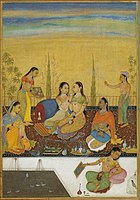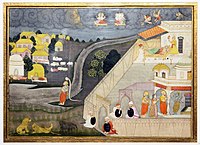Bikaner style of painting
The Bikaner style of painting is a
During the reign of Raja Karan Singh (r. 1632–69) there were close connections with the court of the emperor Shah Jahan, while the imperial workshops were still flourishing, and some Mughal-style subject matter began to appear late in this reign. Karan Singh's youngest son, Anup Singh (later raja, 1674–98), was a general commanding Mughal forces, especially in the Deccan, where he was based in Hyderabad for some time. This very likely accounts for the Deccan influences apparent in later paintings. His best artist, Ruknuddin (Rukn/h ud din Firuz), travelled with him, and many other Bikaner painters were relatives of his; other artists emigrated from the Deccan to Bikaner.[2]
Description
The subjects painted often originate from Indian mythology. Raja Rai Singh was particularly influenced by Mughal art. They painted scenes from the Ragmala, Bhagavata Purana, and Rasalila.
What distinguishes the Bikaner style of painting[3] from other Rajasthani styles of painting are finer lines and a more reserved range of colours than what are typically present in Mughal artwork. Ali Raza painted paintings of Lakshmi Narayana and a portrait of Karan Singh. Ruknuddin used the technique of painting fountains and court scenes using a nature-based background. Later Bikaneri art focused on Bikaner’s architecture such as havelis in the city. Bikaneri artists displayed their work outside royal courts giving businessmen and landlords the chance to appreciate this style of art.[4]
-
The Gopis Plead with Krishna to Return Their Clothing, from a Bhagavata Purana, c. 1610. Metropolitan Museum of Art
-
Gazing Fondly in the Mirror by Natthu Umrani, 1665. San Diego Museum of Art
-
Vishnu revealing his divinity to Vasudeva and Devaki,National Museum, New Delhi, c. 1725.
-
Equestrian Portrait of Maharaja Sujan Singh of Bikaner, by Kasam, Son of Muhammad, 1740s. Brooklyn Museum
-
Artist painting a lady, c. 1780-90. National Museum, New Delhi
References
- ^ Harle, 394-395
- ^ Kossak, 17
- ^ "About Bikaner Miniature Painting Style Rajasthani Miniature Style". Raju Swami. Retrieved 8 June 2016.
- ^ Swami, Mahaveer (9 July 2013). "History of Bikaner Style of Painting and its Contemporary Contexts".
Further reading
- Harle, J. C., The Art and Architecture of the Indian Subcontinent, 2nd edn. 1994, Yale University Press. (ISBN 0300062176
- Kossak, Steven, Indian court painting, 16th-19th century, 1997, Metropolitan Museum of Art, ISBN 9780870997839, fully online






